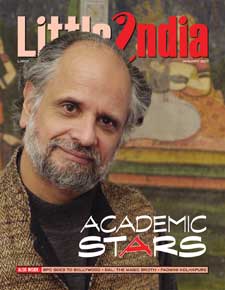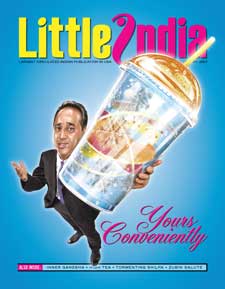Letters
Letters

|
Being mediocre and thrown out of academia 25 years ago, pushed into selling insurance, investments and real estate, I enjoyed reading Lavina Melwani’s article “Academic Stars” (Jan. 2007). Teaching of English by Indians to students in the West has been highlighted in the article, which made me reflect on my days learning English in India.
English as the world’s lingua franca dominates Indian languages and literature in India, especially with the growing emphasis on science and technology. Indian literatures have suffered at the hands of English – Hindi the most. To get recognition and make money in India and abroad, one has to write in English and be published in the West. Several schools have been established in the US and elsewhere outside India to impart education and conduct research on Indian culture and history, as well as in Sanskrit literature, often with generous donations from affluent Indians. But nowhere in these 50 or so schools, have I found an Hindu Indian as professor of the subject or for that matter in Buddhism or Jainism. White, Christians always teach Sanskrit and Indian culture. What an anomaly. Can we find a Hindu Indian teaching Christianity and Western culture in American or British Universities or even in India? I have not read much of Amartya Sen, the Nobel laureate, featured in your article, except The Argumentative Indian, which is very enjoyable and makes excellent reading, save for its India bashing and venomous comments against BJP. Has Sen written on the ills of western society, its political system, especially in the US and UK, where he has spent most of his academic life? Recognition in the West comes from reciting Shakespeare and speaking out against Hinduism and Indian culture, not by admiring the Vedas and Sanatan Dharma, which were founded on the principles of self-upliftment and betterment of humanity rather than prizes and materialistic glories, which is why they are neglected by Indians in India and abroad. But Indian culture and Sanskrit had its own adherents in Ramkrishna, Vivekanand, Aurobindo, CV Raman, Raman Maharshi, JC Bose, Tagore, Gandhi, Prabhupad, to name a few, who influenced the West so much. A report on them would bring a very noble, but different and proud reflection on Indian educators. I enjoy your articles and find it refreshing that you publish candid viewpoints on several issues. This encourages me to share my thoughts on the recent discussion in the media of the “manglik” issue surrounding Aishwarya Rai (Feb 2007). It is interesting that people are upset with movies like Water, yet little is done to counter the notion that the female is always at fault even for her horoscope.It is amusing to hear and read that if a girl was born under certain planets, she can be termed “manglik” and has to marry a tree to be worthy of marriage to a man. Would a man be asked to marry a tree or something else if he had a mangal? Is there a guarantee marrying a tree first would work? I enjoyed the article “Yours Conveniently,” showing the success of South Asians in the industry. As a regular reader of Little India I see many articles on the accomplishments of Indians but none on those facing problems, e.g. with green cards. Thousands of Indians are facing difficulties with immigration. Your article notes that a million dollars were collected for the construction of a temple, but people are indifferent to the real problems of immigrants who are tied up in immigration delays. We need help so that lawmakers on Capitol Hill will listen to us. If Shilpa Shetty were an ordinary individual on the reality show Big Brother she would not have garnered as much sympathy (“O, Sister,” Feb 2007). As she is a Bollywood queen and attractive there was this outpouring of support for her. I find it appalling that the same Indians do not stand up to condemn the treatment meted out to the “Dalits,” and the scheduled castes/tribes in India. Many of them still are treated very unfairly. Guess that is the difference between being rich and famous and poor and downtrodden, right? I wish the author had brought up that point too instead of focusing on Shilpa and her reality show for which she was already compensated rather handsomely and is out to make more. True she deserves some sympathy, but not enough to merit headlines nor a big writeup in Little India.
I am writing in response to the letter by Sophia (Feb 2007) commenting on white skinned people in Hindi movies. She is looking at the trees and missing the forest. Just because a few whites show up in the background (was this a movie set in the US?), doesn’t mean that if you are white you get a part in Hindi movies. Let’s take a look at the top heroes and heroines. Amitabh Bachchan and Shahrukh Khan, are as brown as they come. Amitabh had to battle better looking and lighter skinned heroes like Rajesh Khanna and Dharmendra and we all know how that ended up. Who is the top heroine today? Rani Mukherjee? The previous top actress was Madhuri Dixit. It’s not as if white skinned actors are making a late entry to Hindi cinema. Yester-year actresses like Babita, Vimi and Shakila were no more than B-grade heroines. Back in the 1970s a battle raged between Parveen Babi (white) and Zeenat Aman (dark skinned) for the title of the “Western” girl, it was no contest – Zeenat won by a mile. It is pretty clear that at least in Hindi Cinema, unlike Hollywood, good looks or skin color will not take you far. The Indian cinema-goer has always preferred good acting to looks. Top actors like Bachchan, Jaya Bhaduri, Shabani Azmi, Nutan, Nargis, etc. rose to the top because of their acting skills, decidedly not their looks. The only white actress to rise to the top in the last 50 years was Madhubala, and if you think it was because of her skin color, you need to have your eyes checked. I think it is inappropriate to discuss the engagement of Abhishek Bachchan and Aishwarya Rai (“To Be Mrs B,” Feb 2007), as this is a personal family matter and the media has no right or reason to form opinions. Even writing on such personal family matters for public consumption is wrong. Apart from Dr. Tulasi Polavarapu, (“The Midway Generation,” Dec 2006), I did not read about any of this generation using their American affluence to help the less fortunate in India. The stereotype of the Indian in America is frugal (euphemism for being monetarily cheap). This was commented on by one of your readers a few issues ago. I hope it is the first or immigrant generation that has created this stereotype and the Midway generation will share their good fortune with their less fortunate brethren in India. |


